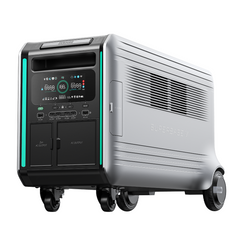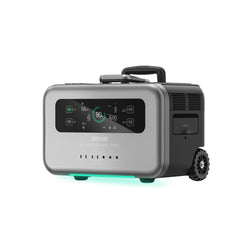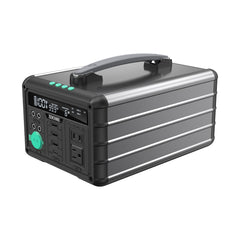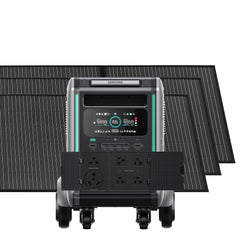The Science Behind Calculating Solar Panel Output: What You Need to Know
As renewable energy becomes increasingly important in our society, more and more people are turning to solar power to reduce their carbon footprint and save money on energy costs. However, to get the most out of a solar panel system, it's essential to have a thorough understanding of how it works and what factors affect its output.
The output of a solar panel system refers to the amount of electrical energy it produces over a given period, typically measured in kilowatt-hours (kWh). Understanding how to calculate and optimize solar panel output can help you determine the size and configuration of your solar panel system, estimate your energy savings, and even make more informed decisions about energy usage.
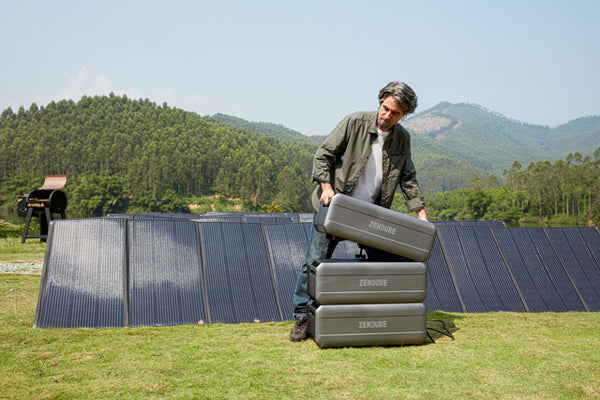
Understanding Solar Panel
Power Rating: Wattage, Voltage, and Amperage
Understanding the power rating of a solar panel is essential when designing and installing a solar energy system. Solar panels are rated in watts (W), which measures the power they can generate under standard test conditions (STC). STC refers to industry-standard test conditions, including a solar irradiance of 1,000 watts per square meter, a cell temperature of 25 degrees Celsius, and a spectral light distribution.
The wattage rating of a solar panel can vary from a few watts for small portable panels to several hundred watts for large, high-powered meetings. When calculating the power output of a solar panel, it is essential to consider its voltage and amperage ratings. A solar panel's voltage (V) refers to the electrical potential difference between the positive and negative terminals. In contrast, amperage (A) refers to the electrical current flowing through the panel.
DC/AC Ratio
Solar panels generate direct current (DC) electricity, which is not suitable for use in most homes and businesses. An inverter is required to convert the DC electricity generated by the solar panels into alternating current (AC) electricity that electrical appliances and devices can use. The DC/AC ratio refers to the ratio of the solar panels' DC power output to the inverter's AC power output.
For example, if a solar energy system has a DC/AC ratio of 1.2, it means that the DC power output of the solar panels is 20% higher than the AC power output of the inverter. In this case, the system would need an inverter with a capacity of at least 20% higher than the DC power output of the solar panels.
The DC/AC ratio is essential when designing a solar energy system. A too-high ratio can result in a waste of power and higher system costs, while a too-low ratio can decrease energy production and efficiency. The optimal DC/AC ratio will depend on several factors, including the size and configuration of the solar energy system, the efficiency of the solar panels and inverter, and the electrical demands of the home or business.
Factors Affecting Solar Panel Output
1. Intensity and Duration of Sunlight
The amount of sunlight that reaches your solar panels is the most critical factor in determining their output. The sun's intensity can vary depending on the time of day, the season, and the weather conditions. For example, solar panels produce more energy on a clear day with direct sunlight than on a cloudy day with diffuse sunlight.
The duration of sunlight is also essential, as solar panels only produce energy when exposed to sunlight. The total amount of sun that your solar panels receive over a day will depend on factors such as the angle and orientation of your meetings and any obstructions or shading that may be present.
2. Angle and Orientation of Solar Panels
The angle and orientation of your solar panels can also significantly impact their output. Solar panels are typically most efficient when facing directly toward the sun, which means that the angle and orientation of your panels will depend on your geographic location and the time of year.
Solar panels in the Northern Hemisphere should face south, while solar panels in the Southern Hemisphere should face north. The optimal angle for solar panels will also depend on your latitude, with steeper slopes being more effective in areas with lower margins and flatter angles being more effective in areas with higher spaces.
3. Temperature and Weather Conditions
Temperature and weather conditions can also affect solar panel output. In general, solar panels are less efficient at high temperatures, as heat can cause the electrical resistance of the board to increase, reducing its production. On the other hand, cooler temperatures can increase the efficiency of solar panels.
Weather conditions such as clouds, rain, and snow can also reduce the output of solar panels, as they can block or scatter sunlight. However, it's worth noting that even on cloudy or overcast days, solar panels can still produce some energy, albeit at a reduced rate.
4. Efficiency of the Solar Panels
The efficiency of solar panels is a critical factor that affects their output. Efficiency refers to the energy a solar panel can convert from sunlight into usable electricity. Solar panel efficiency is impacted by several factors, including the type and age of the panels, how they are operated and monitored, maintenance, and solar shadings.
Type & Age
The type and age of solar panels can significantly impact their efficiency. Three main types of solar panels are available on the market today: monocrystalline, polycrystalline, and thin-film.
Monocrystalline solar panels are the most efficient, with an efficiency rate of around 20-22%. They are made from single-crystal silicon, which allows them to convert a higher percentage of sunlight into electricity. Polycrystalline solar panels are slightly less efficient, with an efficiency rate of around 15-17%. They are made from multiple silicon crystals and are less expensive than monocrystalline panels.
Thin-film solar panels are the least efficient, with an efficiency rate of around 10-12%. They are made from amorphous silicon, cadmium telluride, or copper indium gallium selenide. While thin-film panels are less expensive than crystalline panels, they are also less durable and have a shorter lifespan.
The age of solar panels can also impact their efficiency. Over time, solar panels can degrade due to exposure to sunlight, weather conditions, and other factors. As panels degrade, they become less efficient and produce less electricity. The degradation rate of solar panels varies based on factors such as the type of panels, the installation's location, and the panels' quality.
Operation and Monitoring
Proper operation and monitoring of solar panels are essential to maintaining their efficiency. Solar panels should be installed in a location that receives adequate sunlight and is free from obstructions that can block sunlight. They should also be oriented to maximize their exposure to sunlight.
In addition, solar panels should be connected to an inverter that converts the DC energy produced by the panels into AC energy that can be used in your home or business. The inverter should be sized correctly for the system to maximize its efficiency.
Regularly monitoring your solar panel system is also crucial to maintaining its efficiency. Monitoring can help identify any issues or malfunctions impacting the system's output. It can also help you identify patterns and trends in energy production and usage, which can inform adjustments to optimize your system's output.
Maintenance
Regular maintenance is essential for ensuring your solar panel system's long-term efficiency and performance. Some maintenance tasks you can perform include:
- Cleaning the panels to remove dirt, debris, and other obstructions that can block sunlight
- Checking the wiring and connections to ensure they are tight and secure
- Inspecting the panels for signs of damage or wear and tear
- Replacing any damaged or worn-out components
- Checking and maintaining the inverter to ensure it is functioning correctly
- Regular maintenance ensures that your solar panel system is operating at peak efficiency and producing the maximum amount of electricity.
Solar Shadings
Solar shadings, such as trees, buildings, or other obstructions, can significantly impact the efficiency of your solar panel system. Shading can reduce the sunlight reaching your panels, decreasing energy production.
Solar panels should be installed in a location that receives ample sunlight throughout the day to avoid shading. Trees, buildings, and other obstructions should be removed or trimmed to ensure they do not cast shadows on your panels.
In cases where shading cannot be avoided, technologies such as micro-inverters or power optimizers can be used to mitigate the impact of shading on your solar panel system's efficiency. Micro-inverters and power optimizers optimize individual panels' output rather than the entire system. This allows shaded panels to continue producing energy at their maximum capacity, even if other panels are shaded.
Overall, the efficiency of solar panels is affected by several factors, including the type and age of the panels, how they are operated and monitored, maintenance, and solar shadings. By understanding these factors and taking steps to optimize your system, you can ensure that your solar panels are operating at peak efficiency and producing the maximum amount of electricity possible.
How to Calculate Solar Panel Output
Step 1: Determine the Wattage of the Solar Panels
The first step is to determine the wattage of the solar panels in your system. This information should be readily available from the manufacturer or installer of your solar panel system.
Step 2: Calculate the Solar Panel’s Efficiency
Next, you'll need to calculate the efficiency of your solar panels. This can be done by dividing the output wattage of the board by its rated wattage. For example, if a 250 W solar panel produces 200 W of power, its efficiency would be calculated as 200/250 = 0.8 or 80%.
Step 3: Calculate the Total Number of Solar Panels in Your System
Once you have the wattage and efficiency of your solar panels, you'll need to calculate the total number of meetings in your system. This will depend on the size of your system and the amount of energy you need to produce. Generally speaking, a more extensive system with more solar panels will have more power.
Step 4: Estimate the Average Sunlight Hours per Day in Your Area
The next step is to estimate the average amount of sunlight your solar panels will receive daily. This will depend on your geographic location and the time of year. You can use online resources or consult with a solar panel installer to estimate your area's average sunlight hours per day.
Step 5: Calculate Your Total Daily Solar Panel Power Output
Using the information that you've gathered in the previous steps, you can now calculate the total daily output of your solar panel system. This can be done by multiplying the wattage of your solar panels by their efficiency and then multiplying that result by the total number of meetings in your system. Finally, you'll need to multiply that result by the average sunlight hours per day in your area to get your total daily solar panel output.
For example, if you have a 10 kW solar panel system with 40 250 W panels and an efficiency of 80%, and you estimate that you'll receive an average of 5 hours of sunlight per day in your area, you would calculate your daily solar panel output as follows:
Daily Solar Panel Output = (40 panels x 250 W per panel x 0.8 efficiency) x 5 hours per day
= 4,000 W x 5 hours per day
= 20,000 Wh or 20 kWh per day
Step 6: Determine your energy needs and adjust your solar panel system accordingly
The final step is determining your energy needs and adjusting your solar panel system accordingly. This will depend on how much energy you use daily and how much energy you want to produce with your solar panel system. If your daily energy usage exceeds your solar panel system's output, you may need more solar panels to meet your energy needs.
Other Tools and Resources for Solar Panel Output Calculator
1. Online Solar Panel Calculators
To use an online solar panel calculator, you must provide some basic information about your location, energy needs, and the specifics of your solar panel system, such as panel size, efficiency, and orientation. The calculator will then estimate your system's output and how many panels you need to meet your energy needs.
One benefit of using an online solar panel calculator is that it can help you quickly compare different solar panel systems and configurations. By inputting other variables, you can see how various factors can impact the output of your system, and you can make adjustments to find the optimal configuration for your energy needs.
However, it is essential to note that online solar panel calculators provide estimates only, and your actual output may vary based on factors such as weather conditions and the efficiency of your system. Consider using an energy monitoring system to measure your solar panel system's production accurately.
2. Energy Monitoring Systems
There are two types of energy monitoring systems: hardware-based and software-based. Hardware-based energy monitoring systems typically involve the installation of a physical device that connects to your solar panel system and tracks energy usage and production. On the other hand, software-based systems use software to monitor and analyze energy data.
One of the benefits of using an energy monitoring system is that it allows you to track your energy usage and production over time. By analyzing this data, you can identify patterns and trends in your energy consumption and production and make adjustments to optimize your system's output.
Energy monitoring systems can also provide alerts if there are any issues with your solar panel system, such as a drop in output or a malfunctioning panel. This can help you identify and address problems quickly, minimizing downtime and maximizing your system's production.
3. Solar Panel Software
One of the benefits of using solar panel software is that it allows you to experiment with different configurations of your system to find the optimal setup. By simulating the performance of your system under different conditions, you can identify the best orientation for your panels, the optimal number of boards to install, and other factors that can impact your system's output.
Solar panel software can also provide valuable insights into the long-term performance of your system. By analyzing data over time, you can identify patterns and trends in your system's performance and make adjustments to optimize your output.
Overall, online solar panel calculators, energy monitoring systems, and solar panel software are all valuable tools for estimating and optimizing the output of your solar panel system. By using these tools, you can make informed decisions about the design and installation of your system, and you can maximize your energy production and savings over time.
Understanding solar panel output is crucial for maximizing the benefits of solar energy. Various factors affect solar panel output, including sunlight intensity and duration, panel angle and orientation, temperature and weather conditions, and the efficiency of the solar panels. It's important to consider all of these factors when calculating the output of a solar panel system.
Understanding solar panel output will become increasingly important as the world moves towards more sustainable energy sources. By maximizing the production of solar panel systems, we can reduce our reliance on fossil fuels and create a cleaner, more sustainable future for future generations.
